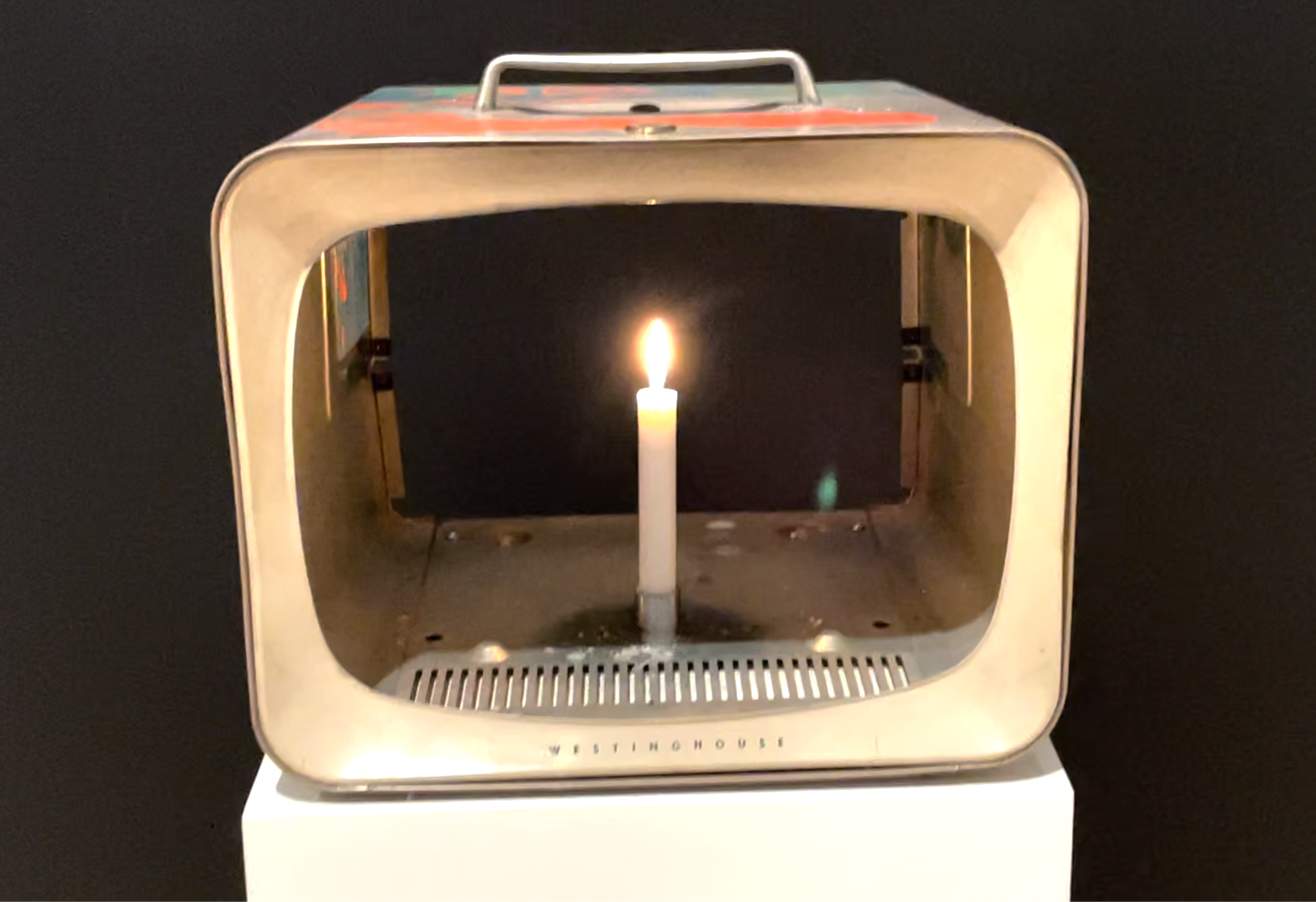Image: Photo by the author of Nam June Paik’s Candle-TV, on display at the SFMOMA in September 2021
What is a creativity state of mind? Heck, what is a state of mind in the first place?? “I’m in a New York State of mind,” goes the song. What does that mean? I want to be back in that immersive environment. I long to return to that place. I rise up and welcome it, internally. My being is tuned to that New York frequency. Well, San Francisco frequency if we’re nit-picking.
And now we have it. A creativity state of mind is when our being – our world model, our paradigm – is tuned to that creativity frequency.
This brings me to Bohm’s television metaphor for enfoldment and unfoldment. A television receives a broadcast signal, but it is not the signal. Studying the television set is an indirect and oblique way of studying the signal at best. When we move our set around the house, adjust its rabbit ear antenna, adjust its color and brightness settings, it affects how we experience the content of the signal. It does not, however, affect the signal itself.
This is how I view creativity. We are the television sets, the receivers, receptors, receptacles. Cosmic consciousness is the signal. It is always there, always accessible to us, and we need to tune into that channel to see/experience it (or at least add it to our consciousness cable bundle). Just like with ESPN, I can receive a channel signal and not experience it because I don’t tune in to it. That doesn’t mean ESPN isn’t there: ESPN is always there. To experience it, my set must be on, turned to that channel, and primed for good reception.
This, then, is my view of a creativity state of mind.
This is also why I take such a firm stance on the whole over the parts: we’re mucking about with device settings and thinking we’re studying the source. We’re not. It’s like Plato’s cave, where we take the shadows on the wall as actual reality. It’s not, though.
Plato encouraged us to just turn around already and see the truth of existence, join in with the truth of existence. Bohm encouraged us to look more holistically at these universal energies.
At the end of the day, creativity exists independent of us, yet we seem to treat it as a self-generated process. We do these things, we are creative. I am one of Kuhn’s (1962) extraordinary scientists contributing to a paradigm shift: understanding creativity for the universal force it is, like love, rather than viewing the receiver as the received. The creativity state of mind is our attunement and condition to receive, channel, express creativity.
Perhaps this is a paradigm shift that comes with an expanded view of reality. My traffic signal incident put me on a different paradigmatic path, one from which I view certain things as unimportant. They are unimportant because our efforts to understand are paltry and insignificant in comparison to the phenomenon we are trying to touch.
As a creativity researcher, this becomes a bit of a challenge. How do I go all Bohm with my approach towards creativity like he did with his approach towards physics? Through the holoverse, each part contains the whole. The universe in a grain of sand, as it were. What does that mean for me and creativity? Do I find value in the work of others? Yes, even as I reframe the context from seeking the source of creativity to amplifying the effectiveness of the instrument of creativity – ourselves. This becomes a bit like a theological study now, I think – how do we purify ourselves as instruments of God?
Creativity is a ubiquitous force, an integral part of cosmic consciousness. Because of my belief in Brahman/Atman, I as Atman are Brahman, cosmic consciousness. Therefore, creativity is a ubiquitous force, an integral part of my own consciousness.
Thinking back to the history of psychology, there’s that pivotal moment with the Enlightenment where western humankind, who once attributed all greatness and inspiration to God, embraced a new paradigm: human beings were the source of their own greatness, inspiration, and genius. We can see the effects of this throughout science, through our assertion of ourselves as the ones who can and will figure out the secrets of the universe. Operating from what Bohm would have called their explicate order, these early scientists worked within existing paradigms and constraints. Because all they had was a hammer, every scientific problem became a nail. No, that’s not the right metaphor. Because all they had was a microscope and a knife, every scientific problem became atomized for its solution.
Look the frick up, already. Stop looking at the shadows thinking you’ve got things all figured out or are on the right path. You’re missing so damn much.

